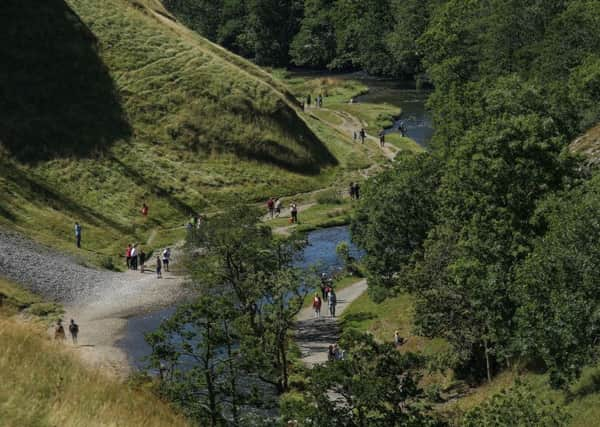Travel review: The trails and dales of the Peak District


As Tennyson wrote: “The hills are shadows, and they flow from form to form, and nothing stands; they melt like mist, the solid lands, like clouds they shape themselves and go,” and to nowhere are these lines more apposite than the southern Peak District, where the limestone peaks take on such dramatic and contrasting shapes when seen from different angles.
Yes, Yorkshire has her Moors and has her Dales but for those looking to go beyond the county, the Peak District is a genuine alternative to the Lake District for its attractive scenery. Being a National Park, in fact the very first, it’s protected against adverse change for the benefit of all, including the high proportion of us concentrated in large cities.
Advertisement
Hide AdAdvertisement
Hide AdThe landscape has a distinctive network of dry stone walls in varying states of good health and disrepair.
Each walk I chose was very different with its dips and troughs, with dales of sheep and trails growing over the old railway lines that connected Derby with her northern neighbours. I climbed the yesteryear ‘squeeze stiles’ to tackle the vast expansive scenery. And the plants of the grasslands include wonderful names like ‘red rattle’ and ‘eyebrights’, ‘sneezeworts’ and ‘devil’s-bit scabious’. As Gerard Manley Hopkins wrote: “What would the world be, once bereft of wet and of wildness? Let them be left, O let them be left, wildness and wet; long live the weeds and the wilderness yet”.
Beginning my walk at The George, the quaint pub beside the 12th century church in Alstonefield, I strolled down to Milldale to trek over the Viator bridge and along the Dovedale valley where the rock formations dramatically punctuate its course. It’s a delightful and easy ‘on a level’ walk through peaceful ash woodlands and past towering limestone pillars. Each feature has a name such as Lover’s Leap and Reynard’s Arch along with biblical references to Jacob’s Ladder, the Twelve Apostles and the Heights of Abraham. It reminded me of Exmoor’s Watersmeet, though the valley is craggier and the water calmer.
The next morning I went horse riding and to go from two legs to four, I descended into Tissington, the feudal village near Ashbourne, to enjoy the wonderful Trekking Centre run by Suzy Torr. After 20 years she has a choice of 20 horses for my escorted ride. Her treks are for all ages and all abilities.
Advertisement
Hide AdAdvertisement
Hide AdTo give my legs a complete rest I jumped in my car. In spring the weather is capricious with rain and snow, sun and clarity all manifest. My car met with gambolling lambs, seeking succour beneath their bleating mothers, and warming themselves on the tarmac defiantly as though protesting at my intervention. What could I do with such seeming innocence? I had to get past to turn back! My car horn and lights had no effect and only a strong clap of hands eventually persuaded them to shift.
I felt strongly the nurturing simplicity of the area with its Methodist chapels and old post offices, pubs with names like “The Old Dog’ and ‘The Cat and Fiddle”, old petrol pumps and candle workshops, small butchers and tearooms, in part for tourists, in part for locals. A style of living refreshing unspoilt and set back in time.
Sadly but inevitably the dialect of the Derbyshire villages is disappearing but the following onomatopoeic words have been captured for eternity: ‘blorting’ for the noise made by cattle when distressed from hunger or when in heat; ‘hummering’ for the very particular sound sheep make just before they give birth; ‘flinkering’ for the breezeless drifting down of light snow and ‘gloppened’ for being lost for words.
Such is the reliance on water supply that the wells are granted an annual thanksgiving service and these occur across a number of villages. At Tissington the great drought of 1615 has ever after caused villagers to ‘dress’ their wells with floral decorations and panels. And the individual stamp of each village is also shaped by the contours of the landscape. I descended into magical fords past houses varying from the humble cottage to the grand estate. One church, as at Thorpe, can have a truncated tower that in turn can become a domestic feature as at the Old Hall at Fenny Bentley, one of the memorable names for a village along with Belper, Water-cum-Jolly Dale and Alsop-en-le-Dale.
Advertisement
Hide AdAdvertisement
Hide AdI stayed at Peveril of the Peak, a house added to with extensive wings to become a guesthouse owned by HF Holidays, a company devoted to ramblers. For young and old, for groups and single people, their system is highly organised with packed lunches requested the night before and very much an ‘early to bed, early to rise philosophy’. The hearty hot fresh dinners were a perfect end to my days of exertion.
The hotel is perfectly positioned beneath the flat-topped Thorpe Cloud which legend has it was trampled on by a giant and near the tree-sprinkled Bunster Hill and the Stepping Stones, the final destination for many who walk beside the river Dovedale. And it’s right next to the village of Ilam that outdoes even the Hay Festival with its stunning setting for her own Dovedale Arts Festival (happening this year from June 8 to 10). The beauty of the landscape and lifestyle of the Peak District left me truly ‘gloppened’!
GETTING THERE
Spend your holiday doing whatever you fancy; visit local places of interest, take a relaxing stroll or try something more challenging.
All of HF Holidays (www.hfholidays.co.uk) 18 UK country houses offer 3 night self guided breaks.
Prices start from £275 per person and include full board accommodation. To book or to request to a brochure call 0345 470 7558 or visit www.hfholidays.co.uk